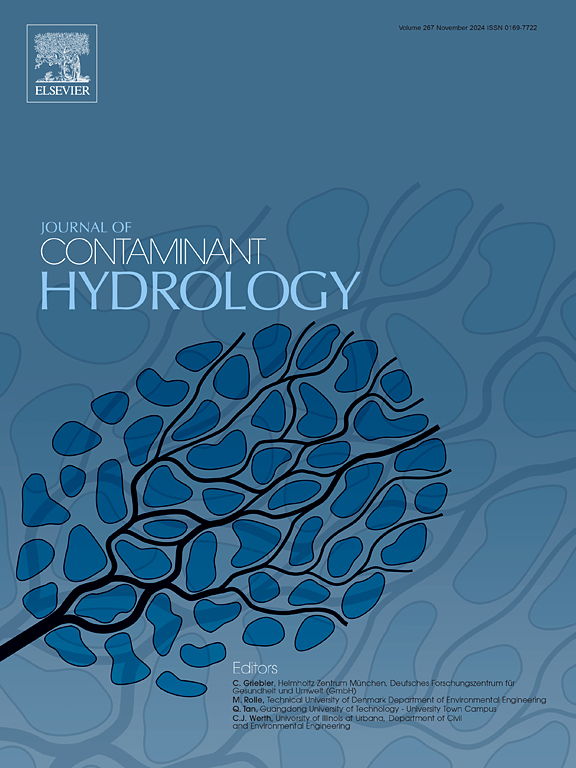地下水波动期间土壤中铁和锰转化的实验见解
IF 4.4
3区 环境科学与生态学
Q2 ENVIRONMENTAL SCIENCES
引用次数: 0
摘要
铁(Fe)和锰(Mn)是土壤-地下水系统中关键的氧化还原敏感元素,它们的主要环境风险在于它们能够影响共同发生的有害污染物(如砷)的动员和释放。以前的研究主要集中在Fe/Mn水相浓度的变化上。然而,在波动的地下水条件下,土壤中不同形态Fe/Mn的动态转化机制尚未得到充分探讨。本研究通过动态地下水位模拟实验解决了这一空白。研究了土壤中不同形态铁锰对地下水位波动的响应,定量评价了不同形态铁锰对地球化学过程的贡献率。结果表明,地下水位的降低增加了氧化还原电位(Eh),形成了一个氧化环境,促进了氧化结合的铁/锰(Ox-Fe/Mn)的富集和有机质结合的铁/锰(Om-Fe/Mn)的减少。对于铁,只有Ox-Fe和Om-Fe形态受到地下水位波动的影响,而交换态(ex -Fe)和碳酸盐结合态(Carb-Fe)则保持在较低水平,变化不显著。然而,这四种形式的锰都随着地下水位的波动而显著变化。定量分析表明,涉及氧-铁/锰的氧化还原过程是土壤-地下水系统中铁/锰循环的主要驱动因素,平均贡献率超过50%。该研究为了解土壤中铁和锰的命运和转化提供了关键见解,并旨在评估其潜在的环境风险。本文章由计算机程序翻译,如有差异,请以英文原文为准。

Experimental insights into iron and manganese transformation in soil during groundwater fluctuations
Iron (Fe) and manganese (Mn) are key redox-sensitive elements in soil-groundwater systems, and their primary environmental risk lies in their ability to influence the mobilization and release of co-occurring hazardous contaminants, such as arsenic. Previous studies have primarily focused on variations in aqueous-phase concentrations of Fe/Mn. However, under fluctuating groundwater conditions, the dynamic transformation mechanisms of different forms of Fe/Mn in soil remain underexplored. This study addressed this gap by employing dynamic groundwater table simulation experiments. The responses of various forms of Fe and Mn in the soil to fluctuations in groundwater levels were investigated and quantitatively evaluated the contribution ratios of different Fe/Mn forms to geochemical processes. The results show that a decrease in the groundwater table increases the redox potential (Eh), creating an oxidative environment that promotes the enrichment of oxide-bound iron/manganese (Ox-Fe/Mn) and a reduction in organic matter-bound iron/manganese (Om-Fe/Mn). For Fe, only the Ox-Fe and Om-Fe forms are affected by groundwater level fluctuations, while the exchangeable form (EXC-Fe) and carbonate-bound form (Carb-Fe) remain at a low level with insignificant changes. However, all four forms of Mn change significantly with the groundwater level fluctuations. Quantitative analysis revealed that redox processes involving Ox-Fe/Mn are the primary drivers of Fe/Mn cycling in the soil-groundwater system, contributing more than 50 % on average. This research provides key insights into the fate and transformation of Fe and Mn in soil and aims to assess their potential environmental risks.
求助全文
通过发布文献求助,成功后即可免费获取论文全文。
去求助
来源期刊

Journal of contaminant hydrology
环境科学-地球科学综合
CiteScore
6.80
自引率
2.80%
发文量
129
审稿时长
68 days
期刊介绍:
The Journal of Contaminant Hydrology is an international journal publishing scientific articles pertaining to the contamination of subsurface water resources. Emphasis is placed on investigations of the physical, chemical, and biological processes influencing the behavior and fate of organic and inorganic contaminants in the unsaturated (vadose) and saturated (groundwater) zones, as well as at groundwater-surface water interfaces. The ecological impacts of contaminants transported both from and to aquifers are of interest. Articles on contamination of surface water only, without a link to groundwater, are out of the scope. Broad latitude is allowed in identifying contaminants of interest, and include legacy and emerging pollutants, nutrients, nanoparticles, pathogenic microorganisms (e.g., bacteria, viruses, protozoa), microplastics, and various constituents associated with energy production (e.g., methane, carbon dioxide, hydrogen sulfide).
The journal''s scope embraces a wide range of topics including: experimental investigations of contaminant sorption, diffusion, transformation, volatilization and transport in the surface and subsurface; characterization of soil and aquifer properties only as they influence contaminant behavior; development and testing of mathematical models of contaminant behaviour; innovative techniques for restoration of contaminated sites; development of new tools or techniques for monitoring the extent of soil and groundwater contamination; transformation of contaminants in the hyporheic zone; effects of contaminants traversing the hyporheic zone on surface water and groundwater ecosystems; subsurface carbon sequestration and/or turnover; and migration of fluids associated with energy production into groundwater.
 求助内容:
求助内容: 应助结果提醒方式:
应助结果提醒方式:


